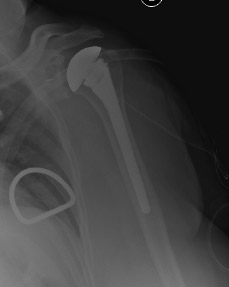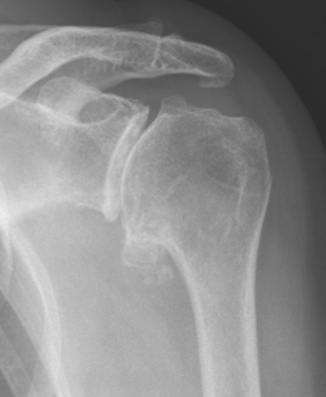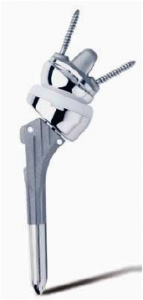There are many types of arthritis. The three most common are osteoarthritis, post traumatic arthritis, and cuff tear arthroapthy.
Osteoarthritis
Primary osteoarthritis of the shoulder results from slow degenerative change in the shoulder joint, and is related to the aging process. Over time cartilage on the joint surface becomes roughened and loses its lubrication properties. This can often result in stiffness and pain in the shoulder region.
Post-Traumatic Arthritis
Post-traumatic arthritis results from trauma to the shoulder region. This may involve a fracture or damage to the joint surface of the shoulder at the time of injury. Recurrent dislocations of the shoulder can also cause shoulder damage an destruction.
Cuff Tear Arthropathy (arthritis)
This is a combination of:
- Ineffective and torn rotator cuff
- Loss of central position of the shoulder joint, with migration of the head of the humerus upwards
- Degenerative changes in the shoulder joint, resulting from 1. and 2. above.
Not all people who have a rotator cuff tear will develop arthritis. It is only a certain portion of the population who have shoulders which are unable to function correctly, after a tear in the rotator cuff who will develop this problem.
Diagnosis
After taking a history of the pain and function of the shoulder, a physical examination to assess pain or tenderness and to look for signs of injury to surrounding tissues is conducted. During this process the ligaments, muscles and tendons will be assessed, along with an assessment of the range of movement.
Tests that might be arranged to diagnose osteoarthritis of the shoulder, or rule out other forms of arthritis, include:
- X-rays and scans such as MRI
- Blood tests
Treatment
Initially, osteoarthtis of the shoulder is treated non-operative measures.
- Taking over-the-counter nonsteroidal anti-inflammatory drugs such as ibuprofen or aspirin. These medications will reduce inflammation and pain. Check with your doctor to make sure you can take these drugs safely.
- Resting the shoulder joint.
- Performing physiotherapy as recommended.
- Performing range-of-movement exercises. These exercises are used in an attempt to increase flexibility.
- Applying moist heat.
- Applying ice to the shoulder. Ice is applied for 20 minutes two or three times a day to decrease inflammation and pain.
- Using other medications prescribed by the GP.
Surgery
 If non-surgical treatments do not work effectively, there are surgical treatments available. As with any surgery, there are certain risks and potential complications including infection or problems with anaesthesia. Surgical treatments include:
If non-surgical treatments do not work effectively, there are surgical treatments available. As with any surgery, there are certain risks and potential complications including infection or problems with anaesthesia. Surgical treatments include:
- Shoulder joint replacement (total shoulder arthroplasty). Replacing the whole shoulder with an artificial joint is usually done to treat arthritis of the glenohumeral joint.
- Reverse total shoulder replacement – in this case both the ball and socket of the shoulder are replaced, however their orientation is swapped around to provide improved function. This option is particularly useful in arthritis associated with rotator cuff tears.
- Replacement of the head of the humerus, or upper arm bone (hemiarthroplasty). This option, too, is used to treat arthritis of the glenohumeral joint in selected cases.
Removal of a small piece of the end of the collarbone (resection arthroplasty). This option is the most common procedure for treating arthritis of the AC joint. After the removal of the end of the bone, the space fills with scar tissue.


